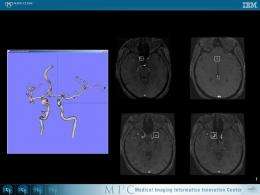Mayo Clinic and IBM advance early detection of brain aneurysms

Preventing deadly ruptures of the blood vessels in the brain is the aim of a new Mayo Clinic project to help radiologists detect aneurysms with far greater speed and accuracy. The new method uses analytics technology developed by the Mayo and IBM collaboration, Medical Imaging Informatics Innovation Center and has proven a 95 percent accuracy rate in detecting aneurysms, compared with 70 percent for manual interpretation. Project findings were reported in the Journal of Digital Imaging (published online Nov. 24, 2009).
Already saving patients' lives, the project has examined more than 15 million images from thousands of patients since the project began in early July. It uses technology that combines advanced imaging with analytics to highlight likely aneurysms for faster detection. This helps radiologists identify them before they result in brain hemorrhage or neurological damage. In the future, Mayo Clinic expects to use the same approach for other radiology detection tests such as the diagnosis of cancer or vessel anomalies in other parts of the body.
"This fully automatic scheme is significant in helping radiologists detect aneurysms in magnetic resonance angiography exams," says Mayo radiologist Bradley Erickson, M.D., senior author of the study and co-director of the Medical Imaging Informatics Innovation Center at Mayo Clinic.
One out of 50 people in the United States has an unruptured brain aneurysm -- an abnormal outward bulging in the blood vessels in the brain -- and about 40 percent of all people who have a ruptured brain aneurysm will die as a result.
Traditionally, a patient suspected of having a brain aneurysm due to a stroke, traumatic injury or family history would undergo an invasive test using a catheter that injects dye into the body, a technique with risks of neurologic complications. To improve the process of detection using noninvasive magnetic
resonance angiography imaging technology, Mayo Clinic and IBM worked to create so-called "automatic reads" that run detection algorithms immediately following a scan.
Once images are acquired, they are automatically routed to servers in the Mayo and IBM Medical Imaging Informatics Innovation Center located on the Mayo campus in Rochester, a collaborative research facility that combines advanced computing and image processing to provide faster, more accurate image analysis. There algorithms align and analyze images to locate and mark potential aneurysms -- even very small ones less than 5mm -- so specially trained radiologists can conduct a further and final analysis.
From the time an image is taken to the time it is ready to be read by a radiologist, there often is only a 10-minute window. In that 10 minutes, the new workflow is able to identify images coming off of the scanners and route those related to the head and brain through the special workflow which then conducts automated aneurysm detection. On average, this can be done in three to five minutes, improving efficiency and saving valuable radiologist's time, leading to a quicker diagnosis which is especially important in the case of a serious aneurysm.
"Our joint work with Mayo Clinic on this project taps IBM's deep expertise in high performance computing and applies it to health analytics, enabling us to remove some of the time and efficiency barriers and making imaging an even more valuable preventative screening tool. Enabling broad access to this capability via cloud delivery is the natural next step," said Bill Rapp, IBM's CTO of Healthcare and Life Sciences and co-director of the Medical Imaging Informatics Innovation Center.















